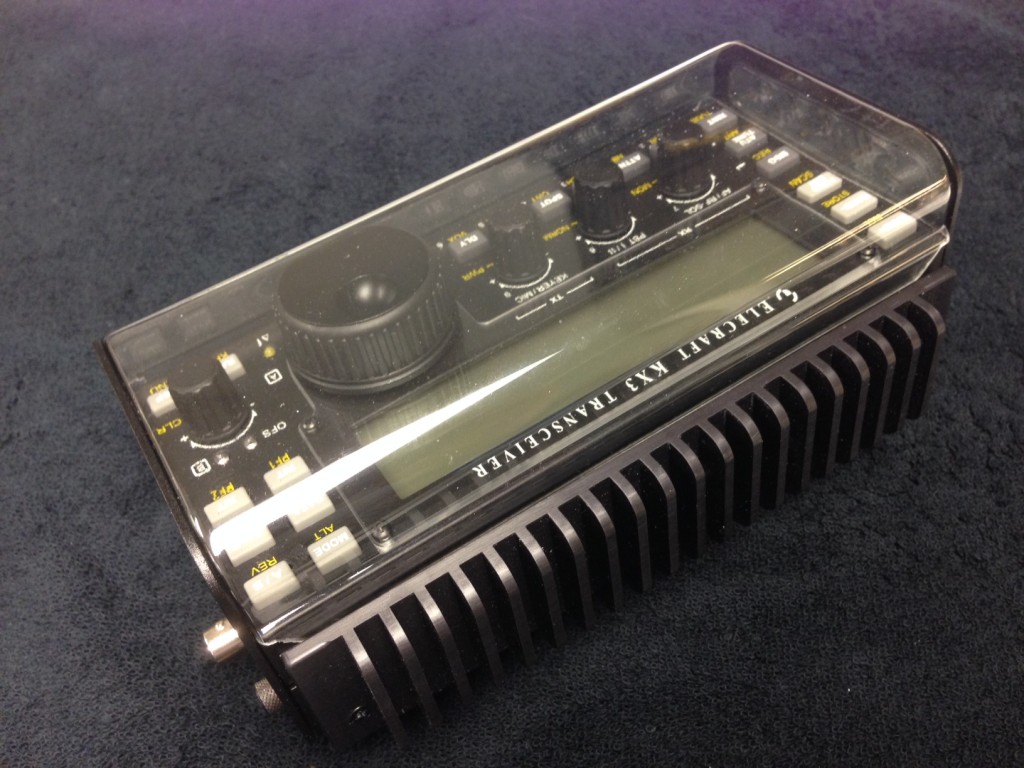I love my 2-year old KX3, simply the best all mode QRP portable rig I’ve ever used. The popularity of the radio is evidenced by an ever-growing marketplace providing accessories. Due to thermal issues experienced by those running digital modes with the KX3, accessory heatsinks have started appearing from several vendors. After evaluating three different designs, I chose the PAE-Kx31 Heatsink by Pro Audio Engineering.
While I was unlucky enough to hit a period of time when they were out of stock, the wait was well worth it, as I was very impressed with the product when it arrived yesterday. There were no rough or sharp edges, the entire heatsink was nicely finished and black anodized to match the appearance of the KX3. The instructions offered three installation methods from laughably simple, to slightly more complex. I chose the most complex for performance reasons, and the entire modification involved removing 4 screws, 2 nuts, and took about 15 minutes — 98% of which was scraping some of the powder-coat off the original KX3 enclosure for better heat transfer (covered by either the original heat plate should you decide to put it back, or the new heatsink).
I’m anxious to try this with JT9, which has been impossible to use in the past due to thermal drift (despite trying the enhanced thermal calibration multiple times). See below the photograph for thermal results.
Here is a photograph of the installed product. Note that it is 100% compatible with my favorite accessory, the GEMS Products Side KX side plates and cover.
Edited: During a cycle of ten 1 minute on and 1 minute off tests at 5.0 watts, the PA reached a max of 36C during transmit, while the oscillator probe was at 37C. It would fall back down during the off interval to PA=30C and Osc=35C. Similar tests run at 10.0 watts, showed a maximum PA=50C and OSc=44C. During the 1 min off interval, the temperature would be PA=35C and Osc=36C. These tests were done at 22C ambient.
Prior to the modification, at 5 watts output, the PA temperature would rise into the mid-60C range, in less than a minute, then cause a high temp trip at 5 watts. I could never get more than 3 watts out for long duration transmissions.










Dear Sir,
The heatsink on the picture above is extreamly good looking and gives the radio a very professional look. I would like to know, is it any drilling work of new holes to be done before mounting of the new heatsink? I mean it is not easy to start making new holes in this expensive piece of equipment. Vy 73’s de Lars
Hi Lars,
There are no holes to be drilled, and you can put the radio back to original condition at any time. While there are THREE different ways of installing the heatsink, the best from a thermal point of view requires you to remove the original heat “plate” by removing four screws. Then an area of paint on the case that is usually covered by the stock heat “plate” is removed for maximum thermal transfer to the new heatsink. So in my case, I could remove the new heatsink, and put the original heat “plate” back on, and nobody would know that I had done anything. In all cases, no new holes, nothing messed up.
I thought it was a pretty sweet looking myself, and it certainly enabled me to operate higher power long duration digital modes with ease.
73, Bob, WB4SON
Hi Bob
I also like my KX3 (#0603) and just sold my FT-950 to finance the KXPA100. The plan was to use the new combo as my main rig with the advantage of being able to unplug the KX3 and hit the road whenever I operate portable. One problem. I do a lot of digi work, especially JT9. Looks like the KX3 is useless die dugi, undoubtedly for thermal reasons. I haven’t done the temperature compensation procedure yet, but that looks like the generally accepted “fix”, although I’ve also seen disappointing results as well. There’s a huge heat sink on the amp and I’m wondering whether the Pro Audio heatsink might do the trick? I never run digi at anything over 40 watts (usually 10 watts on JT9), so I’m also wondering if there is a way to reduce the KX3 drive power to get 30 watts or so from the amp? I need to study the manual. I’d appreciate your thoughts.
73,
Marc, W4MPS
w4mps@nc.rr.com
Hey Marc,
I had mixed results with the extended thermal compensation. Every time I ran it (a process that takes a couple of hours), I ran into some weird readings right around the 50-60 degree mark, exactly where the rig would stay at about 3 watts output.
However, I’ve made several contacts at 10 watts using the external heatsink.
Elecraft did a great job of designing the rig for CW and SSB users. You can tell there was some thermal issues because they bolted an extra “plate” on, which is simply a thermal mass (but not a very good radiator). That was enough for CW/SSB, but that thermal mass becomes saturated quickly on a 50 second JT-X transmission even at 3 watts. The accessory heatsink is a much larger thermal mass and also radiates effectivelly. So it really keeps the PA (and therefore the Oscillator) temps way down.
Look below the picture and you will see the results (quite positive). I am VERY happy with my heatsink.
Many thanks Bob. I appreciate your thoughts. I’m now in touch with Howie WA4PSC about the PAE-Kx31 and am trying to understand how the addition of the KXPA100 amp might (or might not) compound the problem. I’ve now heard several so-so comments about the Elecraft temperature compensation procedure. It looks a little daunting- HI. I’ll probably wind up doing it but would be a happy camper if the problem was solved with just the addition of the heat sink. Hope to catch you on the air once I get this problem solved.
73
Marc, W4MPS
I ran into a power limit condition this past weekend while on a SOTA summit. Rig was in direct sunlight, and air temperature was comfortably warm at 4000+ feet ASL. Using an external 12V battery, I could only maintain 10 Watts out for very brief periods. Wondering if working in the shade is needed, or, the added heat sink is the answer? Any thoughts out there? 73, N6CK.
Working in direct sunlight can certainly rapidly elevate any black surface temp, and I expect that was your biggest issue. Keeping direct sunlight off the back (where the stock heatsink plate is located) would be a good idea. In fact, were you to add the accessory heatsink and have it in direct sunlight you might make the problem worse — there is more area to absorb that solar radiation!
You lose your TX heat two ways; from radiation and convection. The stock flat plat simply doesn’t have a lot of surface area, so there is a limit to the amount of heat it can eliminate. 5 watts and no long term transmissions help to keep it happy. I found my KX3 much happier with the external heatsink.
Hi Bob
By way of intro, we have met at the BVARC Consortium and I’m one of the instructors. Just got hold of the KX3 and agree it’s a great machine. I did add the heat sink with the idea of digital ops.
I would like to extend an invitation (open of course) to come back to the Consortium as a guest speaker with digital ops in mind.
Please let me (Jim K1GND or Bob W1YRC) know if you are available and interested.
73 Jim J K1GND